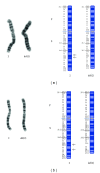Delineation of 2q32q35 deletion phenotypes: two apparent "proximal" and "distal" syndromes
- PMID: 23840981
- PMCID: PMC3690635
- DOI: 10.1155/2013/823451
Delineation of 2q32q35 deletion phenotypes: two apparent "proximal" and "distal" syndromes
Abstract
We report on three patients with interstitial deletions of the long arm of chromosome 2 involving bands 2q32.1-q35. They presented with wide-ranging phenotypic variation including facial dysmorphisms, cleft palate, learning difficulties, behavioural issues and severe heart defects. Microarray analysis confirmed an 8.6 Mb deletion in patients 1 and 2 and a 24.7 Mb deletion in patient 3. We discuss the genes involved in the deleted regions including MYO1B, GLS, FRZB, SATB2, and CPS1 and compare the phenotype with those reported in the literature. Taken together, these data suggest that there is a spectrum of disease severity such that patients with deletions encompassing the region of 2q32.1q32.2, which includes the FRZB gene, show an apparently milder phenotype compared to those that lie further distal in 2q32.3q35 that encompasses the SATB2 gene.
Figures


References
-
- Cocchella A, Malacarne M, Forzano F, et al. The refinement of the critical region for the 2q31.2q32.3 deletion syndrome indicates candidate genes for mental retardation and speech impairment. The American Journal of Medical Genetics B. 2010;153(7):1342–1346. - PubMed
-
- Ramer JC, Mowrey PN, Robins DB, Ligato S, Towfighi J, Ladda RL. Five children with del (2)(q31q33) and one individual with dup (2)(q31q33) from a single family: review of brain, cardiac, and limb malformations. The American Journal of Medical Genetics. 1990;37(3):392–400. - PubMed
-
- Van Buggenhout G, Van Ravenswaaij-Arts C, Mc Maas N, et al. The del(2)(q32.2q33) deletion syndrome defined by clinical and molecular characterization of four patients. European Journal of Medical Genetics. 2005;48(3):276–289. - PubMed
-
- Rifai L, Port-Lis M, Tabet A, et al. Ectodermal dysplasia-like syndrome with mental retardation due to contiguous gene deletion: further clinical and molecular delineation of del(2q32) syndrome. The American Journal of Medical Genetics A. 2010;152(1):111–117. - PubMed
LinkOut - more resources
Full Text Sources
Other Literature Sources
Miscellaneous

